How does the canal operate today ?
The Canal du Midi built by Pierre-Paul Riquet in the 17th century is still in operation today. It has evolved of course, improvements were made by Vauban not long after it was built, and then subsequent improvements have been made throughout the centuries, up to today. It is undergoing continuous modernisation but Riquet's initial design remains intact with his incredible water supply system, winding route and the many locks!
Voies Navigables de France is responsible for the day-to-day running of the Canal du Midi.
Voies Navigables de France Sud-Ouest has a team of 300 working on the 600 km network between the Atlantic and the Mediterranean, including the Canal du Midi and its supply system, and the side canals (Canal de Brienne, Canal de Jonction and Canal de la Robine).
The teams from VNF (lock keepers, maintenance staff, engineers, administrative staff, etc.) ensure the Canal du Midi operates correctly. This includes day-to-day operations, maintenance, management of water resources and the different ways this water is used.
VNF is currently working on a multi-annual project with the French State to modernise the waterway infrastructure.
The management of water supply system
Historic constructions in the Montagne Noire region
The Canal du Midi water supply system is one of the greatest technological achievements for the era the canal was built in the 17th century. As opposed to other canals, the Canal du Midi does not run alongside a river that can supply its water from beginning to end. The Canal du Midi is a summit-level canal that requires a water supply at its highest point which straddles two basins, the Mediterranean and the Atlantic. The highest point of the canal, the Seuil de Naurouze, is supplied with water thanks to an ingenious system designed by Pierre-Paul Riquet. The water from the rivers in the Montagne Noire region are diverted using channels which then flow into storage reservoirs such as Saint-Ferréol to then supply the Canal du Midi.
New dams in the 20th century for the canal water's multiple uses
During the 20th century, several new dams were built in the Montagne Noire region to supply the local populations with drinking water and to irrigate farming land. They were the Cammazes, Galaube, Montbel, Ganguise, Monts d’Orb dams and Jouarres reservoir. Building these dams increased the use of the Canal du Midi waters for irrigation purposes. 40% of the transported water is used for navigation, taking into account filtering and evaporation. The rest of the total volume is used for other uses, the first one being the irrigation of farming land. On the Canal de la Robine, 80% of the water used in the summer period is for farming. The hydraulic management of the canal takes into account any changes in water needs and availability of resources throughout the year.
Other water supply sources
Water inlets from rivers are added to the water supply system in the Montagne Noire, which is not quite enough for the entire canal route. These water inlets are found at the rivers Fresquel, Aude, Cesse, Orb and Hérault.
Modernised infrastructures
The modernisation of locks
Efforts to modernise the locks are not recent! In the late 1990, Voies Navigables de France had already begun adding mechanical and electrical facilities to the locks. Today, there are no lock gates that have to be opened and closed manually. All of them are equipped with motors, and they are mechanically-operated locks. Since 2010, some of the locks on the Canal du Midi have been completely automated. Boaters use a control panel to open and close lock gates. VNF staff verify everything is in correct working order from a distance, and can intervene if needed. Over the next few years, all the Canal du Midi locks between Toulouse and Carcassonne will be automated and controlled remotely.
Optimised hydraulic management
On the Canal des Deux Mers, each branch of VNF Sud-Ouest takes care of the day-to-day management of water, depending on the needs for various uses (navigation, irrigation, drinking water, etc.). Voies Navigables de France works in partnership with other entities to manage the canal, including the Institut des Eaux de la Montagne Noire (IEMN), Compagnie Bas-Rhône-Languedoc (BRL), Institution Interdépartementale pour l’Aménagement du Barrage de Montbel, Syndicat Mixte d’Etudes et d’Aménagement de la Garonne (SMEAG), and EDF. This work is also done alongside water boards and relevant government agencies. VNF also has a role to play in various water management bodies.
Since the 1990s, there has been a slight improvement in the optimisation of water management thanks to the modernised supply system. For example, the gate operating mechanism for the water supply system allows the water volumes to be much better controlled. There are automated systems there to calculate the total water flow passing through. Over the next few years, the goal is to be able to manage the water at all engineering structures from a distance, and so to manage water resources much more efficiently. More than 100 sites and engineering structures (locks, water inlets, dams, etc.) will be equipped, modernised and set up as a network to be controlled remotely, for more reactive management and for a more economical use of water.
The canal in the digital era
Over the past ten years or so, Voies Navigables de France has been rolling out new technology for computer-assisted management and maintenance to monitor the condition of facilities, prevent faults and manage any failures. On a day-to-day basis, VNF staff use digital tablets to input and process data, which is then used to establish annual programmes for preventive maintenance. To meet the needs of these remote management systems, fibre optic or broadband facilities should be installed for all engineering structures.
Building work during annual closure
Every year, there is a closure period for the Canal du Midi so that any necessary building work can be carried out on infrastructure, to maintain and regenerate structures. This period is from the beginning of January to the end of February. Some of the work requires certain canal pounds (section of the canal between two locks) to be emptied either completely or partially, particularly for any work on strengthening or assessing the banks. The canal is then filled with water after this closure period, using the water from the reservoirs and dams.
This closure is followed by a period when navigation is possible but only upon request, for boats that need to use the canal. Then comes the summer season which begins the last Wednesday of March, and boats can use the canals without any restrictions during this time.

Travaux de dragage et nettoyage © VNF
















